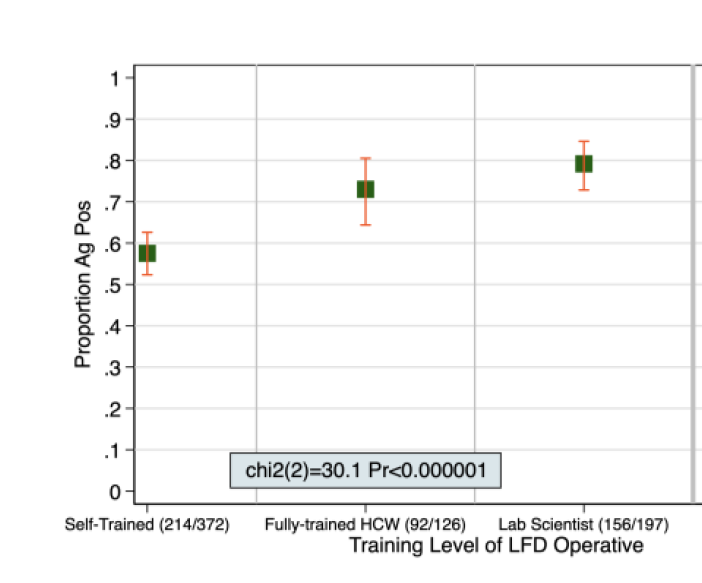
What was the sensitivity and how many false positives were there from Mass Testing of University students?
Results from University of Birmingham and Universities in Scotland don’t make good reading.
SENSITIVITY 3% (not a typo)
42% of Innova positives were FALSE POSITIVES
1/15
Results from University of Birmingham and Universities in Scotland don’t make good reading.
SENSITIVITY 3% (not a typo)
42% of Innova positives were FALSE POSITIVES
1/15
Testing at @unibirmingham was done in our Great Hall – impressively now a testing centre. We retested a random sample of 710 Innova test negs using PCR. We haven’t heard of anybody else doing this. Preprint soon, but here are key results.
2/15
.
2/15
.
Our results were posted on Twitter by @alanmcn1 who organised the testing in real time, and were sent to @DHSCgovuk at the same time.
3/15
3/15
7,189 students were tested 2-9th Dec. Students self-swabbed under supervision. Innova tests were performed immediately by a testing team member (drawn from PG and final year UG science/medicine students in the Uni) supervised by highly experienced post-doctoral researchers
4/15
4/15
We detected 2 Innova positives from 7,189 – our test positive rate was 0.03% (95% CI 0.02% to 0.10%). This is in line with the unexpectedly low rates from other Universities. Both tested positive on PCR, with Ct values of 20 and 25.
5/15
5/15
We randomly sampled 10% (actually 710/7183) Innova test negatives and retested their samples with PCR (based on Ct<=35 on at least 2 genes defining a positive in our TurnKey lab). We found 6 false negative cases with Ct values of 29 29 31 31 33 and 34.
6/15
6/15
We thus estimate that we found 2 cases and will have missed 60 (because we only double tested 10%). We estimate the true prevalence to be 0.86% (95% CI 0.40% to 1.86%) which is much more credible than the 0.03% test positive rate.
7/15
7/15
Our estimate of overall sensitivity is 3.2% (95% CI 0.6% to 15.6%). For cases with Ct<30 sensitivity it is 5.0% (95% CI: 0.8% to 32.1%) and <25 it is 100% (95% CI 15.8% to 100%), but nobody knows whether those with higher Ct values were falling or rising.
8/15
8/15
We especially made sure our students were aware of the real risk of the test missing cases (because we really know about these things here) and advised them to take all precautions when returning home including isolating.
9/15
9/15
Scotland has put its figures together. They didn’t look for false negatives but found 42% (95%CI 25% to 61%) of the Innova test positives were false positives.
beta.isdscotland.org/media/6975/20-…
10/15
beta.isdscotland.org/media/6975/20-…
10/15
So Innova had a sensitivity 3%, positive predictive value 58% when used in University students.
You might want to read that twice.
11/15
You might want to read that twice.
11/15
There are many questions here – why so much worse in students than the public in Liverpool?
12/15
12/15
But most importantly is this a safe use of a test? Does it protect students and staff at school and University? Is it an efficient use of precious resources? (actually that isn’t a serious question) What should Universities do in January? What should happen in schools?
13/15
13/15
This shows how absolutely critical it is that evaluation precedes implementation – these are the only evaluations done in student populations - all done after Government implementation.
Planning proper evaluations first is critical - more are needed.
14/15
Planning proper evaluations first is critical - more are needed.
14/15
Not checking whether a test is fit for the purpose to which it is about to be put is madness and dangerous. Please @DHSCgovuk @MattHancock @GavinWilliamson @CMO_England look at these data and think again as to how you can best keep our students and staff safe.
15/15
15/15
@threadreaderapp unroll
Note - all Kudos for this study goes to @alanmcn1 and his team - I just computed the percentages and confidence intervals (which was slightly more difficult than normal because of the mixed sampling proportions!)
CORRECTION - THERE IS AN ERROR IN THE FALSE POSITIVE RATE IN THESE TWEETS - THERE WERE 18/31 FALSE POSITIVES IN THE SCOTTISH DATA, SO 58% (95%ci 39% TO 75%) WERE FALSE POSITIVE - MANY APOLOGIES.
SORRY I GOT THIS UPSIDE DOWN - IT IS 58% THAT WERE FALSE POSITIVES, NOT 42%. APOLOGIES
• • •
Missing some Tweet in this thread? You can try to
force a refresh






